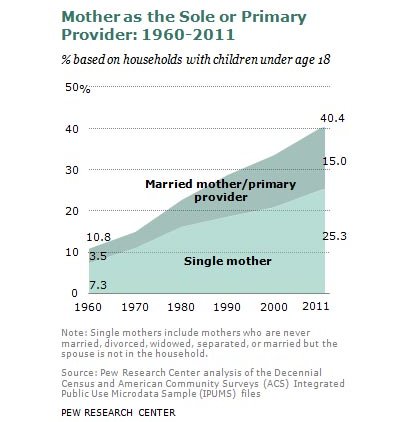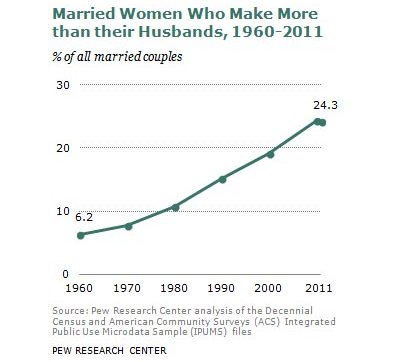An excerpt from a New York Times article by CATHERINE RAMPELL
Women are not only more likely to be the primary caregivers in a family. Increasingly, they are primary breadwinners, too.
Four in 10 American households with children under age 18 now include a mother who is either the sole or primary earner for her family, according to a Pew Research Center analysis of Census and polling data released Wednesday. This share, the highest on record, has quadrupled since 1960.
The shift reflects evolving family dynamics.
For one, it has become more acceptable and expected for married women to join the work force. It is also more common for single women to raise children on their own. Most of the mothers who are chief breadwinners for their families — nearly two-thirds — are single parents.
The recession may have played a role in pushing women into primary earning roles, as men are disproportionately employed in industries like construction and manufacturing that bore the brunt of the layoffs during the downturn. Women, though, have benefited from a smaller share of the job gains during the recovery; the public sector, which employs a large number of women, is still laying off workers.
Women’s attitudes toward working have also changed. In 2007, before the recession officially began, 20 percent of mothers told Pew that their ideal situation would be to work full time rather than part time or not at all. The share had risen to 32 percent by the end of 2012.
The public is still divided about whether it is a good thing for mothers to work. About half of Americans say that children are better off if their mother is at home and doesn’t have a job. Just 8 percent say the same about a father. Even so, most Americans acknowledge that the increasing number of working women makes it easier for families “to earn enough to live comfortably.”
Demographically and socioeconomically, single mothers and married mothers differ, according to the Census Bureau’s 2011 American Community Survey. The median family income for single mothers — who are more likely to be younger, black or Hispanic, and less educated — is $23,000. The median household income for married women who earn more than their husbands — more often white, slightly older and college educated — is $80,000. When the wife is the primary breadwinner, the total family income is generally higher.
Such marriages are still relatively rare, even if their share is growing. Of all married couples, 24 percent include a wife who earns more, versus 6 percent in 1960. (The percentages are similar for married couples who have children.)
Read more HERE: http://www.nytimes.com/2013/05/30/business/economy/women-as-family-breadwinner-on-the-rise-study-says.html?_r=0




